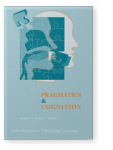Vol. 14:1 (2006) ► pp.83–110
The poetics of bipolar disorder
This article explores the role of affect in the disorganized language and thought that can manifest itself in bipolar disorder. Bipolar disorder, or as it was previously known, manic-depressive illness, can produce psychotic language and thought in its more extreme forms. During the production of discourse in bipolar disorder, there is a strong correlation between the underlying affective state, i.e., depression, euthymia, hypomania, and mania, and linguistic and cognitive performance. A psycholinguistic model of the dynamics between language, thought, and affect in bipolar disorder based on McNeill’s (1992, 2000) concept of a “Growth Point” is proposed. In particular, the poetic structural phases of discourse production in bipolar disorder, which vary according to the underlying affective state, provide a phenomenological bridge between the psychotic discourse of mania and normal language production.
Cited by (5)
Cited by 5 other publications
This list is based on CrossRef data as of 9 june 2024. Please note that it may not be complete. Sources presented here have been supplied by the respective publishers. Any errors therein should be reported to them.
